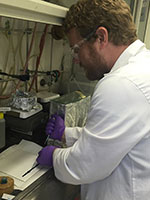
Contact
Triad Technology Center333 Cassell Drive
Baltimore, MD 21224
Education
Ph.D. – Chemistry – Johns Hopkins University (Advisor: Prof. John Toscano)
M.A. – Chemistry – Johns Hopkins University (Advisor: Prof. John Tovar)
B.S. – Chemistry – Randolph-Macon College (Advisor: Prof. John Thoburn)
Research Interests
Daryl Guthrie received his B.S. in chemistry in 2005 from Randolph-Macon College, where under Prof. John Thoburn’s mentorship, he developed squaraine dyes for applications in molecular chiroptical dipole switches and optical data storage. Daryl then obtained his M.A. (2008) and Ph.D. (2014) in chemistry from Johns Hopkins University. Upon completion of his master’s degree studying photochromic conductive materials in Prof. J.D. Tovar’s lab, Daryl joined Prof. John Toscano’s lab. There, he designed HNO prodrug therapeutics for heart failure treatments. After receiving his Ph.D., Daryl continued as a postdoctoral fellow in the Toscano lab, on a project supported by Cardioxyl Pharmaceuticals. In 2015, Daryl became an IRTA Postdoctoral Fellow in Dr. Amy H. Newman’s lab at the Medicinal Chemistry Section of the Molecular Targets and Medications Discovery Branch. Here, he will further pursue his passion for organic chemistry and drug design, by developing novel fluorescent ligands for structure function studies of the dopamine transporter (DAT), mediator of dopamine reuptake from the synaptic cleft and principle target for widely abused psychostimulants, such as cocaine and amphetamine. The fluorescent probes will be applied to study the effects of psychostimulants (and potential medications thereof) on the cellular distribution and trafficking of natively expressed DAT.
Publications
Selected Publications
2017
In: J Med Chem, vol. 60, no. 24, pp. 10172–10187, 2017, ISSN: 1520-4804 (Electronic); 0022-2623 (Linking).
Targeting of dopamine transporter to filopodia requires an outward-facing conformation of the transporter. Journal Article
In: Sci Rep, vol. 7, no. 1, pp. 5399, 2017, ISSN: 2045-2322 (Electronic); 2045-2322 (Linking).
